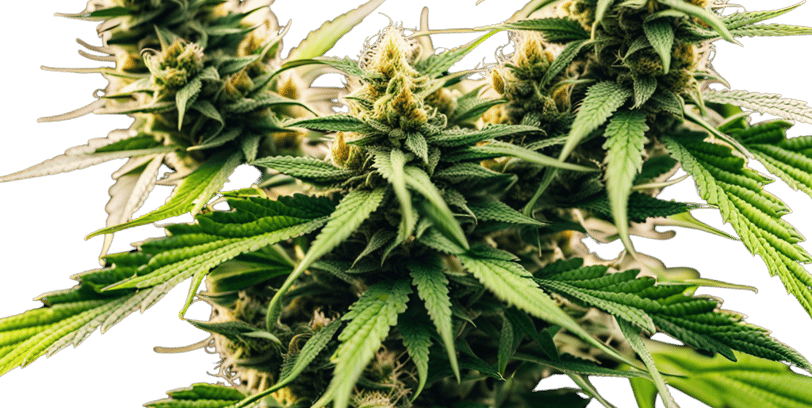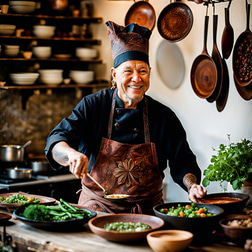
The Power And Magic Of Adding Cannabis Flowers To Foods
Cannabis, often celebrated for its psychoactive and medicinal properties, is finding a new home in the culinary world. As a chef or home cook embracing Culinary Shamanism, incorporating cannabis flowers into meals offers a unique way to harness their therapeutic potential. With compounds like THC and CBD, cannabis can promote relaxation, reduce inflammation, and enhance wellbeing when used thoughtfully. However, its power comes with responsibility. This blog post explores the virtues and precautions of cooking with cannabis flowers, backed by research, practical recipes, and expert advice to help you create medicinal meals that elevate health and vitality.
Abe Dubleveh
4/20/20255 min read


The Virtues of Cannabis in Culinary Arts
Cannabis flowers, particularly from Cannabis sativa and Cannabis indica, contain over 100 cannabinoids, with tetrahydrocannabinol (THC) and cannabidiol (CBD) being the most studied. These compounds interact with the body’s endocannabinoid system, which regulates mood, pain, appetite, and immunity. Here’s why cannabis is a powerful addition to medicinal cooking:
Pain and Inflammation Relief: CBD has anti-inflammatory properties, reducing markers like C-reactive protein by up to 30% in some studies (PMC - Cannabidiol as a Treatment for Chronic Pain). THC complements this by altering pain perception, making cannabis-infused meals ideal for chronic pain sufferers.
Anxiety and Stress Reduction: Low doses of THC (2.5-5 mg) can reduce anxiety, while CBD mitigates THC’s psychoactive effects, promoting calm without intoxication (Healthline - CBD vs. THC).
Appetite Stimulation: THC is known to stimulate appetite, often called “the munchies,” which can benefit those with conditions like cancer or HIV/AIDS (WebMD - Medical Marijuana).
Neuroprotection and Sleep: CBD may support brain health, with studies suggesting it reduces seizures in epilepsy by 40-50% in some cases (NCCIH - Cannabis and Cannabinoids). Both THC and CBD can improve sleep quality, aiding restorative rest.
Incorporating cannabis into meals allows chefs to deliver these benefits in a flavorful, controlled manner, transforming dining into a therapeutic ritual. The “magic” lies in its ability to blend science with sensory delight, aligning with shamanic traditions of using plants for healing.
Precautions for Cooking with Cannabis
While cannabis offers profound benefits, its potency and legal status demand caution. Here are key precautions every chef should take:
Dosage Control: THC’s psychoactive effects vary by individual. A standard edible dose is 2.5-5 mg THC for beginners, as higher doses (10+ mg) can cause anxiety or disorientation (Leafly - Cannabis Dosing 101). Always start low and go slow.
Decarboxylation: Raw cannabis flowers contain THCA and CBDA, which are non-psychoactive. To activate THC and CBD, decarboxylate by baking ground flowers at 240°F (115°C) for 30-40 minutes (Bon Appétit - How to Cook with Cannabis).
Fat Infusion: Cannabinoids are fat-soluble, requiring infusion into butter, oil, or milk. Overheating (above 350°F/175°C) can degrade THC, so use low temperatures during cooking.
Labeling and Storage: Clearly label cannabis-infused foods and store them securely, away from children or unsuspecting diners. Mis-consumption can lead to unintended effects.
Legal Compliance: Cannabis laws vary by region. In the U.S., recreational use is legal in states like California but illegal federally. Verify local regulations before cooking (NORML - State Laws).
Health Considerations: Consult diners’ medical histories. Cannabis may interact with medications or exacerbate conditions like schizophrenia (NCCIH - Cannabis and Cannabinoids). Avoid serving to pregnant individuals or those under 21.
By respecting these precautions, chefs can ensure safe, effective, and enjoyable cannabis-infused meals.
Practical Recipes for Medicinal Cannabis Meals
Below are three recipes that showcase cannabis flowers’ therapeutic potential, designed for ease and precise dosing. Each assumes you’ve prepared cannabis-infused butter (canna-butter) or oil, with a known THC/CBD content (e.g., 10 mg THC per tablespoon).
1. Cannabis-Infused Pesto Pasta
Serves: 4 | Prep Time: 15 minutes | Cook Time: 10 minutes | THC per Serving: ~2.5 mg
This vibrant dish uses cannabis-infused olive oil for anti-inflammatory benefits, paired with basil’s calming properties.
Ingredients:
12 oz spaghetti
2 cups fresh basil leaves
1/4 cup pine nuts
2 cloves garlic
1/2 cup grated Parmesan
1/4 cup cannabis-infused olive oil (10 mg THC/tbsp)
1/4 cup regular olive oil
Salt and pepper to taste
Lemon zest for garnish
Instructions:
Cook spaghetti according to package instructions; drain and set aside.
In a food processor, blend basil, pine nuts, garlic, and Parmesan until smooth.
Slowly add both oils, blending until creamy. Season with salt and pepper.
Toss pesto with warm pasta, ensuring even coating (1 tbsp pesto = ~2.5 mg THC).
Garnish with lemon zest and serve immediately.
Health Benefits: CBD in cannabis oil reduces inflammation, while basil’s eugenol supports relaxation. Perfect for stress relief or mild pain management.
2. Canna-butter-Roasted Root Vegetables
Serves: 4 | Prep Time: 10 minutes | Cook Time: 40 minutes | THC per Serving: ~2.5 mg
This hearty side dish combines cannabis with rosemary for neuroprotection and digestion.
Ingredients:
2 cups carrots, chopped
2 cups parsnips, chopped
1 tbsp cannabis-infused butter (10 mg THC/tbsp)
1 tbsp regular butter
2 sprigs fresh rosemary, chopped
Salt and pepper to taste
Instructions:
Preheat oven to 375°F (190°C).
Toss vegetables with both butters, rosemary, salt, and pepper on a baking sheet.
Roast for 35-40 minutes, stirring halfway, until tender and caramelized.
Serve as a side, ensuring even distribution (~2.5 mg THC per serving).
Health Benefits: THC aids pain relief, while rosemary’s antioxidants support brain health. Root vegetables provide fiber and vitamins for overall vitality.
3. Cannabis-Infused Chai Tea Latte
Serves: 2 | Prep Time: 10 minutes | Cook Time: 10 minutes | THC per Serving: ~2.5 mg
This soothing drink uses cannabis-infused milk for relaxation and sleep support.
Ingredients:
1 cup water
2 black tea bags
1 tsp ground cinnamon
1/2 tsp ground ginger
1/4 tsp ground cardamom
1 cup cannabis-infused whole milk (5 mg THC/cup)
1 tbsp honey
Instructions:
In a saucepan, bring water to a boil. Add tea bags and spices, simmering for 5 minutes.
Remove tea bags, add cannabis-infused milk, and heat gently (do not boil).
Stir in honey, strain into mugs, and serve warm.
Health Benefits: THC and CBD promote relaxation, while cinnamon stabilizes blood sugar. Ideal for evening unwinding or sleep support.
Expert Advice for Culinary Cannabis Use
To maximize the medicinal and magical potential of cannabis in cooking, heed these insights from experts:
Precise Dosing: “Know your potency,” advises chef Monica Lo, author of Sous Weed. “Test your canna-butter’s THC content with a lab or estimate conservatively to avoid overmedicating.” Use a THC calculator (e.g., Leafly’s dosing guide) for accuracy.
Flavor Balance: Cannabis has a strong, earthy taste. Chef Brandon Allen suggests pairing it with bold flavors like garlic, citrus, or spices to mask bitterness without overpowering the dish (Bon Appétit - Cooking with Cannabis).
Set the Intention: “Cooking with cannabis is a ritual,” says herbalist Rachelle Robinett. “Infuse with mindfulness, focusing on healing or joy to enhance the meal’s energy, aligning with shamanic traditions.”
Monitor Effects: Effects from edibles take 30-90 minutes to onset and last 4-8 hours. Advise diners to wait at least 2 hours before consuming more (Leafly - Edibles Guide).
Stay Updated: Follow research from sources like the National Center for Complementary and Integrative Health (NCCIH) or Journal of Cannabis Research to understand emerging benefits and risks.
Precautions in Practice
Beyond the general precautions, consider these practical steps:
Test Batches: Prepare a small test batch to gauge potency and flavor before serving to guests.
Inform Diners: Clearly communicate THC/CBD content and potential effects. Offer non-infused alternatives for those opting out.
Avoid Mixing: Do not combine cannabis edibles with alcohol or other psychoactive substances, as this can amplify effects unpredictably.
The Magic of Cannabis in Culinary Shamanism
Incorporating cannabis flowers into meals is more than a culinary trend—it’s a nod to ancient shamanic practices where plants were revered as allies. By blending cannabis with intention, you create dishes that nourish the body, calm the mind, and elevate the spirit. The magic lies in its dual nature: a scientifically validated medicine and a mystical ingredient that connects us to the earth.
To fully embrace this practice:
Experiment Thoughtfully: Start with low doses and simple recipes, like the ones above, to build confidence.
Document Effects: Keep a journal of how cannabis-infused meals affect your mood, pain, or sleep to refine your approach.
Connect with Community: Share your creations on our site’s forum or social media to learn from other culinary shamans.
Conclusion: A Path to Healing Through Food
The power and magic of adding cannabis flowers to foods lie in their ability to transform meals into therapeutic experiences. With research-backed benefits like pain relief, stress reduction, and improved sleep, cannabis offers a unique tool for enhancing health and vitality. By following precautions, using precise dosing, and drawing on expert advice, chefs can craft dishes that honor both science and shamanic wisdom. Try recipes like Cannabis-Infused Pesto Pasta or Chai Tea Latte to start your journey, and let each bite be a step toward wellbeing.
Ready to explore more? Dive into our site for additional recipes, research, and discussions on Culinary Shamanism. Share your cannabis-infused creations with our community and join the movement to make food a sacred act of healing.
Sources
